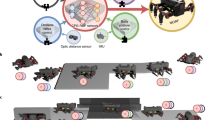Abstract
Neural architectures have been proposed to navigate mobile robots within several environment definitions. In this paper a new neural modular constructive approach to navigate mobile robots in unknown environments is presented. The problem, in its basic form, consists of defining and executing a trajectory to a pre-defined goal while avoiding all obstacles, in an unknown environment. Some crucial issues arise when trying to solve this problem, such as an overflow of sensorial information and conflicting objectives. Most neural network (NN) approaches to this problem focus on a monolithic system, i.e., a system with only one neural network that receives and analyses all available information, resulting in conflicting training patterns, long training times and poor generalisation. The work presented in this article circumvents these problems by the use of a constructive modular NN. Navigation capabilities were proven with the NOMAD 200 mobile robot.




















Similar content being viewed by others
Explore related subjects
Discover the latest articles, news and stories from top researchers in related subjects.Notes
Binary code in which only one bit changes from one state to the other.
References
Jacobs R, Jordan M (1993) Learning piecewise control strategies in a modular neural network architecture. IEEE Trans Sys Man Cybern 23(2):337–345
Haykin S (1999) Neural networks—a comprehensive foundation. Prentice Hall, New York
Sharkey A (ed) (1999) Combining artificial neural networks. Springer, Berlin Heidelberg New York
Ronco E, Gawthrop P (1995) Modular neural networks: a state of the art. Technical report: CSC-95026, Centre for System and Control, University of Glasgow, Glasgow, UK
Parekh R, Yang J and Honavar V (1995) Constructive neural network learning algorithms for multi-category pattern classification. Technical Report TR95–15, Artificial Intelligence Research Group, Department of Computer Science, Iowa State University, Ames, IA
Krose B and van Dam J (1997) Neural vehicles. In: van der Smagt P, Omidvar O (eds) Neural systems for robotics, Academic Press, New York
Baum E, Haussler D (1989) What size net gives valid generalisation? Neur Comput 1:151–160
Auda G, Kamel M (1999) Modular neural networks: a survey. Int J Neur Sys 9(2):129–151
Nehmzow U (1992) Experiments in competence acquisition for autonomous mobile robots. Dissertation, University of Edinburgh
Sarkey N, Heemskerk J (1996), The neural mind and the robot. In: Browne A (ed) Current perspectives in neural computing, IOS Press, Amsterdam, The Netherlands
Kwok T, Yeung D (1997) Constructive algorithms for structure learning in feed forward neural networks for regression problems. IEEE Trans Neur Ntwks 8(3):630–645
Mataric M (1992) Integhration of Representation Into Goal-Driven Behavior-Based Robots. Proceedings of the IEEE Transactions on Robotics and Automation 8(3)
Mayoraz E, Aviolat F (1996) Constructive Training Methods for Feed Forward Neurol Networks with Binary Weights. Int J Neur Sys 7(2)
Mozer M, Smolensky P (1988) Skeletonization: a technique for trimming the fat from a network via relevance assessment. Adv Neur Info Proc Sys 1:107–115
Pomerleau D (1991) Rapidly adapting artificial neural networks for autonomous navigation. Neu Inf Proc 3:429–435
Dracopoulos D (1998) Robot Path Planning for Maze Navigation. Proceedings of the 1988 IEEE World Conference on Computational Intelligence, pp 2081–2085
Schmidt A, Bandar Z (1997) A Modular Neural Network Architecture with Additional Generalisation Abilities for Large Input Vectors. Proceedings of the 3rd International Conference on Artificial Neural Networks and Genetic Algorithms (ICANNGA 97), Springer, Berlin Heidelberg New York, pp 40–43
Jacobs R, Jordan M (1991) A competitive modular connectionist architecture. In: Lippmann et al. (eds) Neural Information Processing Systems 3, vol. 3
Silva C, Cristómo M, Ribeiro B (2000) Monoda: A Neural Modular Architecture for Obstacle Avoidance Without Knowledge of the Environment. Proceedings of the 2000 International Joint Conference on Neural Networks
Ash T (1989) Dynamic node creation in backpropagation networks. Connect Sci 1(4):365–375
Silva C, Cristómo M, Ribeiro B (2000) A Modular Learning Architecture for Navigating NOMAD Mobile Robot. 8th International Conference on Information Processing and Management of Uncertainty in Knowledge Based Systems
Acknowledgements
This work was partially supported by the Portuguese Ministério da Ciência e Tecnologia and the European Union through the R&D Unit 326/94 (CISUC).
Author information
Authors and Affiliations
Corresponding author
Rights and permissions
About this article
Cite this article
Silva, C., Ribeiro, B. Navigating mobile robots with a modular neural architecture. Neural Comput & Applic 12, 200–211 (2003). https://doi.org/10.1007/s00521-003-0383-y
Received:
Accepted:
Published:
Issue Date:
DOI: https://doi.org/10.1007/s00521-003-0383-y




